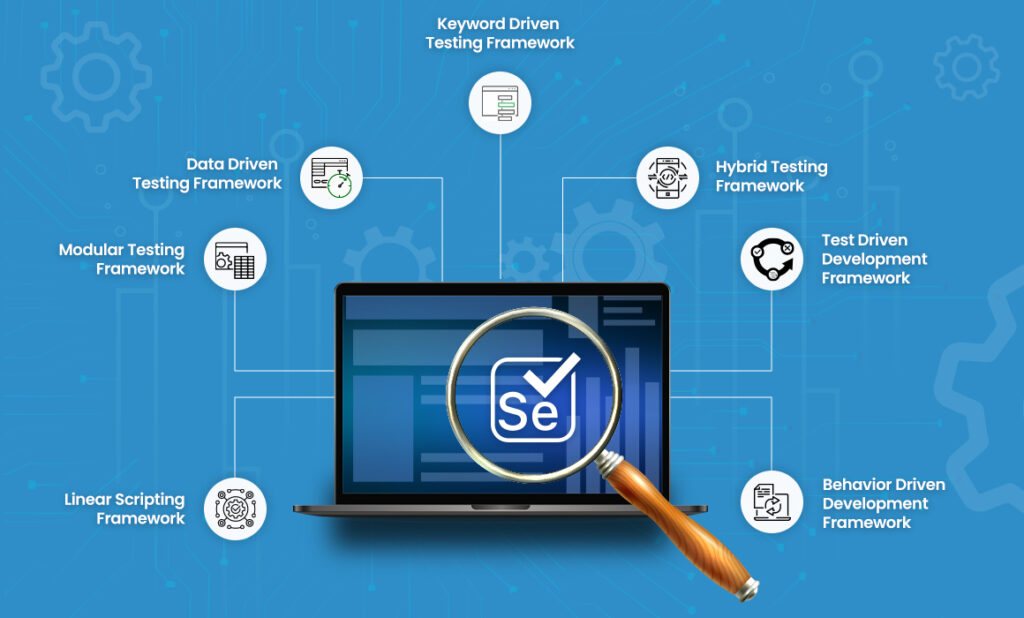Quality Assurance (QA) testing and Selenium testing are terms often used interchangeably in the software development world, but they represent distinct processes with different purposes, methods, and tools. Understanding the differences between these two forms of testing is essential for developers, testers, and businesses aiming to build high-quality software. This blog will explore the key differences between QA testing training and Selenium testing, highlighting their unique characteristics, roles in the software development lifecycle, and how they contribute to overall product quality.
In the case of Selenium testing, it is one of the most widely used open-source Web UI (User interface) automation testing suites. It supports automation across different browsers, platforms and programming languages. Selenium is also easily used on platforms like Linux, Windows, Macintosh, Solaris, amongst others. Also, it supports operating systems for mobile applications like Android, Windows Mobile and iOS. You can learn more about Selenium by enrolling in a Selenium training.
So, without further ado, here are some differences between QA testing and Selenium testing.
Understanding QA Testing
QA Testing, or Quality Assurance Testing, is a comprehensive process that focuses on ensuring the overall quality of software products. QA testing is not limited to just identifying bugs or defects; it encompasses various testing methods and practices designed to ensure that the software meets specified requirements, functions correctly, and provides a positive user experience.
Manual Testing: Involves testers manually interacting with the software to check for bugs or issues.
Automated Testing: Uses tools like Selenium to execute test cases automatically and repeatedly.
Key Aspects of QA Testing:
- Holistic Approach: QA testing takes a broad approach, encompassing different types of testing such as functional, non-functional, regression, integration, and user acceptance testing (UAT). It looks at the product from multiple angles to ensure it works as expected.
- Process-Oriented: QA testing involves evaluating the entire software development process, from requirements gathering to deployment. It ensures that each step follows industry standards, minimizing errors early in the development process.
- Manual and Automated Testing: QA testing includes both manual and automated testing approaches. Manual testing involves testers manually executing test cases without the use of automation tools, while automated testing uses tools to perform testing activities.
- Focus on Prevention: Unlike some forms of testing that primarily identify defects, QA testing emphasizes preventing defects by improving the development process and implementing standards and guidelines.
- Wide Range of Tools: QA testers use a wide array of tools beyond Selenium, including JIRA, TestRail, Postman, and various other automated and manual testing tools.
Understanding Selenium Testing
Selenium is a popular open-source tool suite primarily used for automating web applications for testing purposes. Selenium testing focuses specifically on automating browser-based applications, allowing testers to write test scripts that simulate user interactions.
Unlike broader QA testing, Selenium testing is focused specifically on automated web testing. Selenium allows testers to simulate user interactions with a website, such as clicking buttons, filling out forms, or navigating through pages.
Key Aspects of Selenium Testing:
- Automation-Focused: Selenium testing is dedicated to automating repetitive tasks in web applications, such as form submissions, mouse clicks, and keyboard inputs. This reduces the time and effort required for manual testing.
- Web Application Specific: Selenium is specifically designed for testing web applications. It does not support testing desktop or mobile applications natively, making it less versatile compared to broader QA testing.
- Supports Multiple Browsers and Platforms: Selenium supports major browsers like Chrome, Firefox, Safari, and Edge, and it can run on different platforms, including Windows, macOS, and Linux. This ensures that web applications function correctly across various environments.
- Script-Based Testing: Selenium allows testers to write test scripts using various programming languages, such as Java, Python, C#, and Ruby. These scripts help automate the testing process, making it faster and more reliable.
- Integration with CI/CD Pipelines: Selenium integrates well with Continuous Integration/Continuous Deployment (CI/CD) tools like Jenkins, allowing automated tests to be run as part of the build process. This helps catch issues early in the development cycle.
- Limited Scope: Unlike QA testing, Selenium testing is restricted to automation within web browsers and does not encompass the broader aspects of software testing.
Key Differences Between QA Testing and Selenium Testing
Understanding the distinctions between QA testing and Selenium testing requires looking at their scope, purpose, and approach.
Scope and Coverage
- QA Testing: QA testing covers a wide array of testing activities, including functional, non-functional, performance, security, and usability testing. It looks at the entire product lifecycle and ensures quality from requirements to deployment.
- Selenium Testing: Selenium testing is confined to automating web applications. It does not extend to desktop or mobile applications unless used with other tools, such as Appium. The scope of Selenium is narrow compared to the broad approach of QA testing.
Purpose
- QA Testing: The main goal of QA testing is to ensure that the software meets all quality standards, functions as intended, and delivers a great user experience. It aims to prevent defects, improve processes, and ensure the overall quality of the product.
- Selenium Testing: Selenium testing’s purpose is primarily to automate browser actions to test the functionality of web applications. It aims to reduce manual testing effort by automating repetitive and regression tests.
Approach
- QA Testing: QA testing involves both manual and automated approaches. It uses test plans, test cases, and various testing strategies to validate the software against its requirements.
- Selenium Testing: Selenium testing focuses solely on automation. Testers write scripts in languages like Java or Python to automate user actions in a browser, allowing for quick execution of tests.
Tools and Technologies
- QA Testing: QA testing employs a diverse set of tools, including Selenium for automation but also tools like JIRA for bug tracking, TestNG for test management, Postman for API testing, and LoadRunner for performance testing.
- Selenium Testing: Selenium testing relies on the Selenium suite, which includes WebDriver, IDE, and Grid, to automate web testing. It integrates with other tools like TestNG, JUnit, and Jenkins for comprehensive test execution.
Defect Prevention vs. Detection
- QA Testing: QA testing emphasizes preventing defects by adhering to quality standards, conducting thorough reviews, and continuously improving the development process.
- Selenium Testing: Selenium testing primarily focuses on detecting defects in web applications by executing predefined test scripts. It identifies issues but does not directly address process improvements.
Integration in Development Cycle
- QA Testing: QA testing is integrated into every phase of the software development lifecycle (SDLC), from initial planning to final deployment, and includes both static (requirements review) and dynamic (testing) methods.
- Selenium Testing: Selenium testing is primarily involved in the testing phase of the SDLC. It is used to execute automated tests once the application has been developed, typically during regression or continuous integration stages.
Practical Applications and Use Cases
1. QA Testing Use Case
In a large eCommerce platform, QA testing ensures that the website performs well under high traffic, delivers the correct functionality across different devices, and meets security standards to protect user data. The QA team would perform both manual and automated tests, ensuring the platform works under different scenarios.
2. Selenium Testing Use Case
For the same eCommerce platform, Selenium testing might be used to automate the checkout process. A Selenium script can fill in the checkout form, simulate clicking the “Pay” button, and ensure the order is placed successfully. By automating this repetitive task, the team can run this test across multiple browsers and verify that the checkout process works as expected.
When to Use QA Testing vs. Selenium Testing?
Choosing between QA testing and Selenium testing depends on the project requirements, the nature of the software, and the goals of the testing process.
Use QA Testing When:
- You need a comprehensive testing approach that covers all aspects of software quality, including functional and non-functional testing.
- The software includes web, desktop, and mobile components that need to be tested.
- You aim to improve the development process and prevent defects.
- Manual testing is required to validate user experience and perform exploratory testing.
Use Selenium Testing When:
- The primary need is to automate repetitive tests for web applications.
- You have a mature QA process in place and need to speed up testing through automation.
- The application is web-based and requires testing across different browsers and platforms.
- Regression testing needs to be performed frequently as part of a CI/CD pipeline.
Complementary Nature of QA Testing and Selenium Testing
While QA testing and Selenium testing have distinct roles, they often complement each other in the software development process. Selenium testing is a tool that fits within the broader QA testing strategy. QA testers can use Selenium to automate repetitive tasks, allowing them to focus on more complex and critical testing activities. By integrating Selenium into the QA process, teams can improve efficiency, reduce time-to-market, and maintain high-quality standards.
Conclusion
Both Quality Assurance(QA) testing and Selenium testing are useful testing tools in the world of software development and testing. As much as there are differences between them, it is advisable to understand how the two of them work because it will go a long way in making you a professional in software development and testing.
To gain hands-on experience and in-depth knowledge, consider enrolling in QA testing online courses or a selenium testing certification through H2K Infosys. Our courses are designed to provide practical, real-world skills that will prepare you for the competitive software testing industry.






























